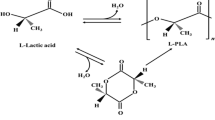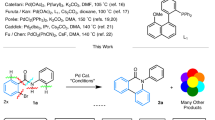Abstract
Sparsely branched polyolefins often exhibit a thermorheological complexity, which was reported to be maskable by a modulus shift. However, the only physical background for a modulus shift is a density change, and this influence factor is only small in the relatively narrow temperature regime accessible by polyolefins. This paper deals with the question, how this modulus shift can be caused by experimental artifacts and real effects. The physical background of these two contributions to a vertical activation energy, as well as a meaningfulness of the application of a modulus shift, is found not to be given for polyolefins, when measuring only in a temperature range between 130 and 230 °C.








Similar content being viewed by others
Notes
Measuring the thermal expansion coefficient of a geometry is actually relatively easy. Most modern rheometers have a normal force control. All that has to be done is to zero the gap at a given temperature (in the case presented here room temperature) and set the normal force control to a low force (here: 0.5 N). Then the temperature is changed and the values of the apparent gap (the real gap is zero!) are recorded. It is important to wait until the gap has fully stabilized before recording the point at the respective temperature (this is usually later than when the temperature has stabilized, as stainless steel is a rather bad heat conductor). In case of the setup used, the required waiting time increased with temperature (because the temperature gradient inside the geometry increases) and was between 5 and 10 min. In order to be sure to be in equilibrium, the chosen waiting time was >30 min.
If a rheometer without a normal force controller is used, a thin steel bar should be put in the gap when zeroing it and removing it before increasing the temperature again – this avoids damage to the air bearing due to thermal expansion. At the desired temperature, the gap is to be determined, at which the geometry and the steel bar are locked to each other in the same way as during the initial zeroing. This way the thermal expansion coefficient can be measured with comparable accuracy to the method proposed for rheometers with normal force control.
Hashmi et al. (2012) found that it is possible to use very big samples (about factor 2 larger than necessary to fill the geometry) to use a constant correction factor for getting correct rheological data of hydrogels during swelling. Remmler T (personal communication, 2015) confirmed the small influence of outward bent surfaces, while inward bent surfaces will significantly reduce the viscosity.
The authors’ experience values on this matter are that for samples with acceptably short relaxation times (shorter than 1 min) and thus zero shear-rate viscosity η 0 (<106 Pas), achieving this is not a significant experimental challenge, but for very high viscosity melts achieving such an optimal sample surface proves difficult.
This is one of the reasons of the inferior reproducibility of such samples. Also the insufficient adhesion of these samples to the geometry and the possible presence of orientations and small fractures play a role (such high viscosity samples tend to be very brittle in the melt, ripping, in some cases, even at a Hencky strain εH below 1 in elongational tests).
In case of very low viscosity samples (η 0 < 100 Pas) the gravity prevents an outwards curvature of the free sample surface.
References
Bates FS (1990) Fluctuation effects in symmetric copolymers near the order–disorder transition. J Chem Phys 92(10):6255
Capodagli J, Lakes R (2008) Isothermal viscoelastic properties of PMMA and LDPE over 11 decades of frequency and time: a test of time-temperature superposition. Rheol Acta 47(7):777–786
Carella JM, Gotro JT, Graessley WW (1986) Thermorheological effects of long-chain branching in entangled polymer melts. Macromolecules 19(3):659–667
Colby RH, Fetters LJ, Graessley WW (1987) Melt viscocity-molecular weight relationship for linear polymers. Macromolecules 20(9):2226–2237
Fulcher GS (1925a) Analysis of recent measurements of the viscosity of glasses. J Am Ceram Soc 8:339–355
Fulcher GS (1925b) Analysis of recent measurements of the viscosity of glasses. II. J Am Ceram Soc 8:789–794
Gabriel C, Kaschta J, Münstedt H (1998) Influence of molecular structure on rheological properties of polyethylenes I. Creep recovery measurements in shear. Rheol Acta 37(1):7–20. doi:10.1007/s003970050086
Hadinata C, Gabriel C, Ruellmann M, Kao N, Laun HM (2006) Shear-induced crystallization of PB-1 up to processing-relevant shear rates. Rheol Acta 45(5):539–546
Hartwig G (1994) Polymer properties at room and cryogenic temperatures. Plenum Press, New York
Hashmi S, Obiweluozor F, Ghavaminejad A, Vatankhah-Varnoosfaderani M, Stadler FJ (2012) On-line Observation of Hydrogels during Swelling and LCST-induced changes. Korea-Aust Rheol J 24(3):191–198
Hashmi S, Vatankhah-Varnoosfaderani M, Ghavaminejad A, Obiweluozor FO, Du B, Stadler FJ (2015) Self-associations and temperature dependence of aqueous solutions of zwitterionically modified n-isopropylacrylamide copolymers. Rheologica Acta 54(6):501–516
Hepperle J, Münstedt H, Haug PK, Eisenbach CD (2005) Rheological properties of branched polystyrenes: linear viscoelastic behavior. Rheol Acta 45(2):151–163
Kapnistos M, Koutalas G, Hadjichristidis N, Roovers J, Lohse DJ, Vlassopoulos D (2006) Linear rheology of comb polymers with star-like backbones: melts and solutions. Rheol Acta 46(2):273–286
Kaschta J, Schwarzl FR (1994a) Calculation of discrete retardation spectra from creep data: 2. Analysis of measured creep curves. Rheol Acta 33(6):530–541. doi:10.1007/BF00366337
Kaschta J, Schwarzl FR (1994b) Calculation of discrete retardation spectra from creep data: 1. Method Rheol Acta 33(6):517–529. doi:10.1007/BF00366336
Kaschta J, Stadler FJ (2009) Avoiding waviness of relaxation spectra. Rheol Acta 48(6):709–713
Kessner U, Kaschta J, Münstedt H (2009) Determination of method-invariant activation energies of long-chain branched low-density polyethylenes. J Rheol 53(4):1001–1016
Liu C-Y, Yao M, Garritano RG, Franck AJ, Bailly C (2011) Instrument compliance effects revisited: linear viscoelastic measurements. Rheol Acta 50(5–6):537–546
Liu C-Y, Halasa AF, Keunings R, Bailly C (2006) Probe rheology: a simple method to test tube motion. Macromolecules 39(21):7415–7424
Lohse DJ, Milner ST, Fetters LJ, Xenidou M, Hadjichristidis N, Mendelson RA, Garcia-Franco CA, Lyon MK (2002) Well-defined, model long chain branched polyethylene. 2. Melt rheological behavior. Macromolecules 35(8):3066–3075
Mavridis H, Shroff RN (1992) Temperature-dependence of polyolefin melt rheology. Polym Eng Sci 32(23):1778–1791
Münstedt H, Schwarzl FR (2014) Deformation and flow of polymeric materials. Springer, Heidelberg
Olabisi O, Simha R (1975) Pressure-volume-temperature studies of amorphous and crystallizable polymers. I. experimental. Macromolecules 8:206–210
Piel C, Stadler FJ, Kaschta J, Rulhoff S, Münstedt H, Kaminsky W (2006) Structure–property Relationships of linear and long-chain branched metallocene high-density polyethylenes characterized by shear rheology and SEC-MALLS. Macromol Chem Phys 207(1):26–38
Resch JA, Keßner U, Stadler FJ (2011) Thermorheological behavior of polyethylene: a sensitive probe to molecular structure. Rheol Acta 50(5–6):559–575
Schwarzl F, Staverman AJ (1952) Time-temperature dependence of linear viscoelastic behavior. J Appl Phys 23:838–843
Stadler FJ, Kaschta J, Münstedt H (2005) Dynamic-mechanical behavior of polyethylenes and ethene-/α-olefin-copolymers. Part I. α′-Relaxation. Polymer 46(23):10311–10320
Stadler FJ, Piel C, Kaschta J, Rulhoff S, Kaminsky W, Münstedt H (2006a) Dependence of the zero shear-rate viscosity and the viscosity function of linear high-density polyethylenes on the mass-average molar mass and polydispersity. Rheol Acta 45(5):755–764
Stadler FJ, Piel C, Klimke K, Kaschta J, Parkinson M, Wilhelm M, Kaminsky W, Münstedt H (2006b) Influence of type and content of various comonomers on long-chain branching of ethene/α-olefin copolymers. Macromolecules 39(4):1474–1482
Stadler FJ, Kaschta J, Münstedt H (2008) Thermorheological behavior of various long-chain branched polyethylenes. Macromolecules 41(4):1328–1333
Stadler FJ, Münstedt H (2009) Correlations between the shape of viscosity functions and the molecular structure of long-chain branched polyethylenes. Macromol Mater Eng 294(1):25–34
Stadler FJ, Bailly C (2009) A new method for the calculation of continuous relaxation spectra from dynamic-mechanical data. Rheol Acta 48(1):33–49
Stadler FJ, van Ruymbeke E (2010) An improved method to obtain direct rheological evidence of monomer density reequilibration for entangled polymer melts. Macromolecules 43(21):9205–9209
Stadler FJ (2010) Effect of incomplete datasets on the calculation of continuous relaxation spectra from dynamic-mechanical data. Rheol Acta 49(10):1041–1057
Stadler FJ, Mahmoudi T (2011) Understanding the effect of short-chain branches by analyzing viscosity functions of linear and short-chain branched polyethylenes. Korea-Aust Rheol J 23(4):185–193
Stadler FJ, Mahmoudi T (2013) Evaluation of relaxation spectra of linear, short, and long-chain branched polyethylenes. Korea-Aust Rheol J 25(1):39–53
Stange J, Wächter S, Kaspar H, Münstedt H (2007) Linear rheological properties of the semi-fluorinated copolymer tetrafluoroethylene-hexafluoropropylene-vinylidenfluoride (THV) with controlled amounts of long-chain branching. Macromolecules 40(7):2409–2416. doi:10.1021/ma0626867
Tammann G, Hesse W (1926) The dependence of viscosity upon the temperature of supercooled liquids. Zeitschrift für Anorganische und Allgemeine Chemie 156:245–257
Vogel H (1921) The law of the relation between the viscosity of liquids and the temperature. Phys Z 22:645–646
Williams ML, Landel RF, Ferry JD (1955) The temperature dependence of relaxation mechanisms in amorphous polymers and other glass-forming liquids. J Am Chem Soc 77(14):3701–3707
Winter HH, Chambon F (1986) Analysis of linear viscoelasticity of a cross-linking polymer at the gel point. J Rheol 30(2):367–382
Wood-Adams P, Costeux S (2001) Thermorheological behavior of polyethylene: effects of microstructure and long chain branching. Macromolecules 34(18):6281–6290
Acknowledgments
The authors would like to thank the Nanshan District Key Lab for Biopolymers and Safety Evaluation (No. KC2014ZDZJ0001A) and Shenzhen City (JCYJ20140509172719311). This paper was inspired by several papers we reviewed and referees of our papers, explicitly asking us for using a modulus shift or questioning this concept.
Author information
Authors and Affiliations
Corresponding author
Rights and permissions
About this article
Cite this article
Stadler, F.J., Chen, S. & Chen, S. On “modulus shift” and thermorheological complexity in polyolefins. Rheol Acta 54, 695–704 (2015). https://doi.org/10.1007/s00397-015-0864-9
Received:
Revised:
Accepted:
Published:
Issue Date:
DOI: https://doi.org/10.1007/s00397-015-0864-9




